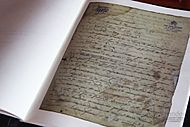Jamaica Letter facts for kids
Quick facts for kids {{{document_name}}} |
|
 |
|
| Created | September 6, 1815 |
| Authors | Simón Bolívar |
The Jamaica Letter (or Carta de Jamaica, also Contestación de un Americano Meridional a un caballero de esta isla "Answer from a southern American to a gentleman of this island") was a document written by Simón Bolívar in Jamaica in 1815. It was a response to a letter from Jamaican merchant Henry Cullen, in which Bolívar explained his thoughts about the social and political situation of the Spanish America at the time, the power of the Spanish Empire and the possible future of the new nations that would be created after its collapse.
Contents
Historical context
The fall of the Second Republic of Venezuela
In order to rebuild the Republic, the Admirable Campaign took Bolívar very rapidly in just a few months to Caracas on August 6, 1813. However, the whole enterprise came to an end in 1814, when the royalist troops of José Tomás Boves finally defeated the patriot forces and forced Bolívar to retreat, with the additional consequence of being proscribed by José Félix Ribas and Manuel Piar. After this defeat in 1814, Bolívar fled Venezuela with his authority lost and disputed by his own officers. The Second Republic of Venezuela was finally abolished.
Return to New Granada
Bolívar departed to Cart on September 8, 1814. He was in New Granada in October 1814 and stayed until April 1815. Nevertheless, Bolívar did not repeat the victorious experience of 1813 because he was a subordinate of the New Granadian authorities, which requested him to fight against the federalist forces (who opposed the centralist dictatorship of Bernardo Álvarez) rather than the loyalist armies. Unable to deal with the civil war that confronted the patriot factions and having neither political power nor the acceptance of several New Granadians, Bolívar decided to resign his military investiture and to leave the Spanish American society.
Exile of Bolívar in Jamaica
The Libertador made his way to Jamaica on May 8, 1815, and he arrived there six days later. Bolívar aspired to get the attention of the British Empire in order to obtain its cooperation, in which the ideal of Latin American independence means economic profit for England. Therefore, Bolívar made efforts to convince the English gentlemen of his proposals, such as giving to England the Spanish American provinces of Panama and Nicaragua to build waterway later developed as the Panama Canal and the Nicaragua Canal. Bolívar lived in Kingston from May to December 1815 with no military activities, but he dedicated his time to think about the future of the American continent, given the situation of the world's politics.
Bolívar did not have in that year any resources to fulfill his projects of emancipation. In 1815, the Libertador gained the sympathy of the British, but he was close to poverty with few material possessions, little money and some slaves; Pío, one of them, tried to assassinate him under the orders given by Pablo Morillo, whose fleet began its voyage from Cádiz to the Spanish America months earlier. In October, Bolívar's economic situation worsened in a point in which he was in despair. .....
Prior to those misfortuned words on October 1815, Bolívar wrote the Carta de Jamaica. Months later, the Libertador was required by his New Granadian fellows to help their resistance against Morillo's troops, but it was too late because the loyalist Pacificador took the city of Cartagena. This event made Bolívar change his course to Haiti in order to get reinforcements from Alexandre Pétion. On December 24, Bolívar was no longer in Jamaica.
The Carta de Jamaica
Overview
The Carta de Jamaica was finished on September 7, 1815, in Kingston. In it, Bolívar began by analyzing what until that time had been considered the historical successes in the struggle for liberty in the Americas. In general terms, it was a balance of force achieved by the patriots in the years from 1810 to 1815. In the middle part of the document are expounded the causes and reasons that justified the "Spanish Americans" in their decision for independence, followed by a call to Europe for it to co-operate in the work to liberate the Latin American peoples. In the third and final part, he speculated and debated on the destiny of Mexico, Central America, New Granada, Venezuela, Río de la Plata, Chile, and Peru.
Finally, Bolívar ends his reflections with an imprecation that he would repeat until his death: the necessity for the union of the countries of the Americas. Even though the Carta de Jamaica was nominally addressed to Henry Cullen, a Jamaican merchant of English origin, it is clear that its fundamental objective was to gain the attention of the most powerful liberal nation of the 19th century, Britain, with the aim that it would decide to involve itself in American independence. However, when Britain finally responded to Bolívar's call, he preferred the help of Haiti.
See also
 In Spanish: Carta de Jamaica para niños
In Spanish: Carta de Jamaica para niños

